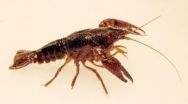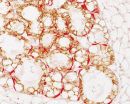(Press-News.org) Researchers from The University of Texas at Austin and five other institutions have created a molecule that can cause cancer cells to self-destruct by ferrying sodium and chloride ions into the cancer cells.
These synthetic ion transporters, described this week in the journal Nature Chemistry, confirm a two-decades-old hypothesis that could point the way to new anticancer drugs while also benefitting patients with cystic fibrosis.
Synthetic ion transporters have been created before, but this is the first time researchers have shown them working in a real biological system where transported ions demonstrably cause cells to self-destruct.
Cells in the human body work hard to maintain a stable concentration of ions inside their cell membranes. Disruption of this delicate balance can trigger cells to go through apoptosis, known as programmed cell death, a mechanism the body uses to rid itself of damaged or dangerous cells.
One way of destroying cancer cells would be to trigger this innate self-destruct sequence by skewing the ion balance in cells. Unfortunately, when a cell becomes cancerous, it changes the way it transports ions across its cell membrane in a way that blocks apoptosis.
Almost two decades ago, a natural substance called prodigiosin was discovered that acted as a natural ion transporter and has an anticancer effect.
Since then, it has been a "chemist's dream," said Jonathan Sessler, professor in The University of Texas at Austin's College of Natural Sciences and co-author of the study, to find "synthetic transporters that might be able to do exactly the same job, but better, and also work for treating diseases such as cystic fibrosis where chloride channels don't work."
Sessler and his collaborators, led by professors Injae Shin of Yonsei University and Philip A. Gale of the University of Southampton and King Abdulaziz University, were able to bring this dream to fruition.
The University of Texas members of the team created a synthetic ion transporter that binds to chloride ions. The molecule works by essentially surrounding the chloride ion in an organic blanket, allowing the ion to dissolve in the cell's membrane, which is composed largely of lipids, or fats. The researchers found that the transporter tends to use the sodium channels that naturally occur in the cell's membrane, bringing sodium ions along for the ride.
Gale and his team found that the ion transporters were effective in a model system using artificial lipid membranes.
Shin and his working group were then able to show that these molecules promote cell death in cultured human cancer cells. One of the key findings was that the cancer cell's ion concentrations changed before apoptosis was triggered, rather than as a side effect of the cell's death.
"We have thus closed the loop and shown that this mechanism of chloride influx into the cell by a synthetic transporter does indeed trigger apoptosis," said Sessler. "This is exciting because it points the way towards a new approach to anticancer drug development."
Sessler noted that right now, their synthetic molecule triggers programmed cell death in both cancerous and healthy cells. To be useful in treating cancer, a version of a chloride anion transporter will have to be developed that binds only to cancerous cells. This could be done by linking the transporter in question to a site-directing molecule, such as the texaphyrin molecules that Sessler's lab has previously synthesized.
The results were a culmination of many years of work across three continents and six universities.
"We have demonstrated that this mechanism is viable, that this idea that's been around for over two decades is scientifically valid, and that's exciting," said Sessler. "We were able to show sodium is really going in, chloride is really going in. There is now, I think, very little ambiguity as to the validity of this two-decades-old hypothesis."
The next step for the researchers will be to take the synthetic ion transporters and test them in animal models.
INFORMATION:
Sessler's co-authors are Sung-Kyun Ko (Yonsei University and Korea Research Institute of Bioscience and Biotechnology); Sung Kuk Kim, Andrew Share and Vincent Lynch (UT Austin); Jinhong Park and Wan Namkung (Yonsei University); Wim Van Rossom and Nathalie Busschaert (University of Southampton); Philip Gale (University of Southampton and King Abdulaziz University); and Injae Shin (Yonsei University). Sung-Kyun Ko and Sung Kuk Kim were the lead authors on this study. Sessler, Gale and Shin were the corresponding authors.
This work was supported by the National Creative Research Initiative program in South Korea; the Office of Basic Energy Sciences in the U.S. Department of Energy; and the Chemical Biology Research Center in the Korea Research Institute of Bioscience and Biotechnology.
Synthetic molecule makes cancer self-destruct
2014-08-11
ELSE PRESS RELEASES FROM THIS DATE:
NIST therapy for ultraviolet laser beams: Hydrogen-treated fibers
2014-08-11
To make a better optical fiber for transmitting laser beams, the first idea that comes to mind is probably not a nice long hydrogen bath.
And yet, scientists have known for years that hydrogen can alter the performance of optical fibers, which are often used to transmit or even generate laser light in optical devices. Researchers at the National Institute of Standards and Technology (NIST) have put this hydrogen "cure" to practical use, making optical fibers that transmit stable, high-power ultraviolet laser light for hundreds of hours. NIST scientists expect these hydrogen-treated ...
Stanford researchers uncover cancer-causing mechanism behind powerful human oncogene
2014-08-11
A protein present at high levels in more than half of all human cancers drives cell growth by blocking the expression of just a handful of genes involved in DNA packaging and cell death, according to a new study by researchers at the Stanford University School of Medicine.
The researchers found that the protein, called Myc, works through a tiny regulatory molecule called a microRNA to suppress the genes' expression. It marks the first time that a subset of Myc-controlled genes has been identified as critical players in the protein's cancer-causing function, and suggests ...
Blood cells are a new and unexpected source of neurons in crayfish
2014-08-11
Researchers have strived for years to determine how neurons are produced and integrated into the brain throughout adult life. In an intriguing twist, scientists reporting in the August 11 issue of the Cell Press journal Developmental Cell provide evidence that adult-born neurons are derived from a special type of circulating blood cell produced by the immune system. The findings—which were made in crayfish—suggest that the immune system may contribute to the development of the unknown role of certain brain diseases in the development of brain and other tissues.
In many ...
How breast cancer usurps the powers of mammary stem cells
2014-08-11
During pregnancy, certain hormones trigger specialized mammary stem cells to create milk-producing cells essential to lactation. Scientists at the University of California, San Diego School of Medicine and Moores Cancer Center have found that mammary stem cells associated with the pregnant mammary gland are related to stem cells found in breast cancer.
Writing in the August 11, 2014 issue of Developmental Cell, David A. Cheresh, PhD, Distinguished Professor of Pathology and vice-chair for research and development, Jay Desgrosellier, PhD, assistant professor of pathology ...
Malaria medicine chloroquine inhibits tumor growth and metastases
2014-08-11
A recent study by investigators at VIB and KU Leuven has demonstrated that chloroquine also normalizes the abnormal blood vessels in tumors. This blood vessel normalization results in an increased barrier function on the one hand -- thereby blocking cancer cell dissemination and metastasis -- and in enhanced tumor perfusion on the other hand, which increases the response of the tumor to chemotherapy.
The anti-cancer effect of the antimalarial agent chloroquine when combined with conventional chemotherapy has been well documented in experimental animal models. To date, ...
Climate change negatively impacting Great Lakes, GVSU researcher says
2014-08-11
MUSKEGON, Mich. -- Climate change is having a direct negative effect on the Great Lakes, including impacts to recreational value, drinking water potential, and becoming more suited to invasive species and infectious pathogens, according to a Grand Valley State University researcher.
The impact of climate change on the Great Lakes, as well as other natural resources in the United States, was explored in the report "Science, Education, and Outreach Roadmap for Natural Resources," recently released by the Association of Public and Land-grant Universities. Kevin Strychar, ...
CRI scientists pinpoint gene likely to promote childhood cancers
2014-08-11
DALLAS – Aug. 11, 2014 – Researchers at the Children’s Medical Center Research Institute at UT Southwestern (CRI) have identified a gene that contributes to the development of several childhood cancers, in a study conducted with mice designed to model the cancers. If the findings prove to be applicable to humans, the research could lead to new strategies for targeting certain childhood cancers at a molecular level. The study was published today in the journal Cancer Cell.
“We and others have found that Lin28b – a gene that is normally turned on in fetal but not adult ...
US immigration is associated with rise in smoking among Latinos and Asians
2014-08-11
Immigration to the U.S. may result in increased smoking in Latino and Asian women, according to new research from sociologists at Rice University, Duke University and the University of Southern California.
The study, "Gender, Acculturation and Smoking Behavior Among U.S. Asian and Latino Immigrants," examines smoking prevalence and frequency among Asian and Latino U.S. immigrants. The research focuses on how gender differences in smoking behavior are shaped by aspects of acculturation and the original decision to migrate. The study was published recently in the journal ...
Kessler Foundation researchers publish study on task constraint and task switching
2014-08-11
West Orange, NJ. August 11, 2014 -- Kessler Foundation scientists have published results of cognitive research that show the negative effects that unexpected task constraint, following self-generated task choice, has on task-switching performance. The article, "You can't always get what you want: The influence of unexpected task constraint on voluntary task switching", was published online on June 11 by The Quarterly Journal of Experimental Psychology (DOI:10.1080/17470218.2014.917115). The authors are Starla Weaver, PhD, and Glenn Wylie, DPhil, of Kessler Foundation, John ...
Study: 1 out of 5 adult orthopaedic trauma patients sought additional providers for narcotic prescriptions
2014-08-11
ROSEMONT, Ill.─"Doctor shopping," the growing practice of obtaining narcotic prescriptions from multiple providers, has led to measurable increases in drug use among postoperative trauma patients. The study, "Narcotic Use and Postoperative Doctor Shopping in the Orthopaedic Trauma Population," appearing in the August issue of the Journal of Bone & Joint Surgery (JBJS), links doctor shopping to higher narcotic use among orthopaedic patients. The data was presented earlier this year at the 2014 Annual Meeting of the American Academy of Orthopaedic Surgeons (AAOS).
"There ...





